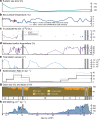Sediment controls dynamic behavior of a Cordilleran Ice Stream at the Last Glacial Maximum
- PMID: 32286283
- PMCID: PMC7156478
- DOI: 10.1038/s41467-020-15579-0
Sediment controls dynamic behavior of a Cordilleran Ice Stream at the Last Glacial Maximum
Abstract
The uncertain response of marine terminating outlet glaciers to climate change at time scales beyond short-term observation limits models of future sea level rise. At temperate tidewater margins, abundant subglacial meltwater forms morainal banks (marine shoals) or ice-contact deltas that reduce water depth, stabilizing grounding lines and slowing or reversing glacial retreat. Here we present a radiocarbon-dated record from Integrated Ocean Drilling Program (IODP) Site U1421 that tracks the terminus of the largest Alaskan Cordilleran Ice Sheet outlet glacier during Last Glacial Maximum climate transitions. Sedimentation rates, ice-rafted debris, and microfossil and biogeochemical proxies, show repeated abrupt collapses and slow advances typical of the tidewater glacier cycle observed in modern systems. When global sea level rise exceeded the local rate of bank building, the cycle of readvances stopped leading to irreversible retreat. These results support theory that suggests sediment dynamics can control tidewater terminus position on an open shelf under temperate conditions delaying climate-driven retreat.
Conflict of interest statement
The authors declare no competing interests.
Figures





References
-
- McNabb RW, Hock R. Alaska tidewater glacier terminus positions, 1948-2012. J. Geophys. Res. Earth Surf. 2014;119:153–167. doi: 10.1002/2013JF002915. - DOI
-
- Molnia BF. Late nineteenth to early twenty-first century behavior of Alaskan glaciers as indicators of changing regional climate. Glob. Planet. Change. 2007;56:23–56. doi: 10.1016/j.gloplacha.2006.07.011. - DOI
-
- Post A, O’Neel S, Motyka RJ, Streveler G. A complex relationship between calving glaciers and climate. EOS. 2011;92:305–312. doi: 10.1029/2011EO370001. - DOI
-
- Felikson D, et al. Inland thinning on the Greenland ice sheet controlled by outlet glacier geometry. Nat. Geosci. 2017;10:366–369. doi: 10.1038/ngeo2934. - DOI
-
- Joughin I, et al. Ice-front variation and tidewater behavior on Helheim and Kangerdlugssuaq Glaciers, Greenland. J. Geophys. Res. 2008;113:F01004.
Publication types
LinkOut - more resources
Full Text Sources

